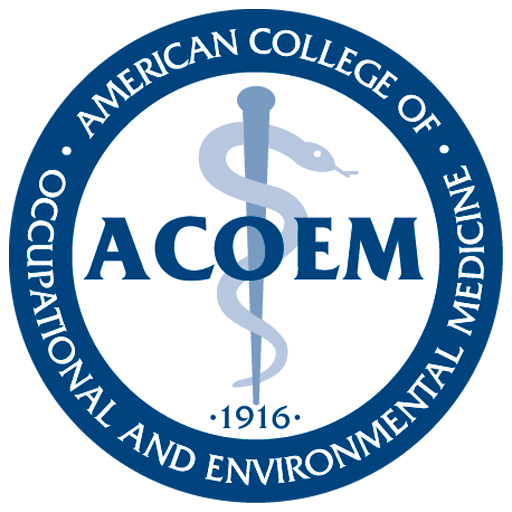
02: Care of the Ill or Injured Worker
It is imperative for primary care providers (PCPs) to recognize and address occupational-related respiratory diseases in the primary care setting. These diseases are those caused or exacerbated by various work factors. This section addresses management of toxic inhalation exposures, occupational asthma, pneumoconiosis, and occupational lung cancers.
Assessment of occupational respiratory diseases requires full attention to the patient’s job description, signs, and symptoms and awareness of occupational concerns that require screening. While caring for such a patient, PCPs should obtain a detailed history, conduct a thorough physical exam, order correct imaging, and conduct pulmonary function testing (PFT).
Evaluation
The occupational history should include the types and duration of exposure to hazardous materials as well as a review of occupational environmental controls and protective respiratory equipment used. In accordance with OSHA, Material Safety Data Sheets (MSDS) should be provided by the employer (although in practice the employee often brings them to the clinic).
Providers must perform thorough physical exams on all patients with possible concerns about occupational exposure. If lung disease is suspected, PCPs should also consider ordering PFTs and imaging such as chest X-rays (two views) or chest CTs. A high-resolution CT scan is recommended over conventional CTs if it is available, because its increased sensitivity can help assess the presence, character, and severity of a variety of diffuse lung disorders.
Pulmonary Function Test
For PFT interpretation, PCPs should follow these steps:
- Calculate the FEV1/FVC ratio.
- Calculate the FVC value.
- Confirm the obstructive or restrictive pattern.
- Grade the severity of the abnormality.
- Determine reversibility of the obstructive defect.
- Perform a bronchoprovocation test if indicated.
- Establish the differential diagnosis
Peak Expiratory Flow Rate Meter
The PEFR meter is a mobile pulmonary device that the patient uses at home, which can detect changes in airway obstruction. A 20% or greater variability in PEFR is an asthmatic response.
Toxic Inhalation Exposure
Screening
Toxic inhalation injuries can occur following industrial, transportation, or fire-related accidents. PCPs must identify the offending gas, duration of exposure, and presenting symptoms. Water-soluble toxins can cause local irritation of conjunctival membranes and upper airways, hoarseness, cough, and bronchospasm. In contrast, water-insoluble toxins are absorbed more distally in the airways and can penetrate the alveoli. If a patient is not screened or treated properly, he or she may develop bronchiectasis, bronchiolitis obliterans, or even persistent asthma. In addition, chemical laryngitis must be ruled out if a patient presents with a badly burned nose or throat, hoarseness, or stridor.
Evaluation
PCPs must assess whether a patient is hemodynamically stable before taking an occupational history, performing an examination, or ordering spirometry or peak flow to measure the degree of the airway obstruction. Providers should consider performing a chest X-ray immediately post-exposure. In some cases, patients who have inhaled a toxic agent have an increased risk of developing chemical pneumonitis or pulmonary edema within four to eight hours of a heavy exposure. PCPs should know that a patient who arrives in the medical office after inhaling a poorly water-soluble agent (such as nitrogen oxide or phosgene) may lack any respiratory distress signs initially but needs to be monitored for a minimum of 24 hours.
Treatment and Prevention
The best treatment is primary prevention through measures such as using recommended personal protective equipment (PPE) and education. While assessing the patient, PCPs should consult the MSDS obtained from the employer for any inhaled toxin. PCPs should treat symptomatic patients with bronchodilators (beta agonist and/or steroid) and sometimes with parenteral steroid intramuscular injection in the office. Immediate decontamination of exposed cutaneous and conjunctival areas is very essential. PCPs should consider oxygen treatment for patients with severe burns, including facial burns, and transfer them to a hospital for direct laryngoscopy or fiberoptic bronchoscopy to rule out laryngeal edema.
Stable patients can be managed in the outpatient setting with medications (inhalers and/or steroid), serial periodic physical examinations, spirometry and/or peak-flow volume measurements, chest X-rays, and pulse oximetry. PCPs should familiarize themselves with the OSHA regulations specifically related to some of these exposures and related medical requirements.
Occupational Asthma
Screening
Occupational asthma occurs in patients who have airway obstruction and/or hyperresponsiveness to an agent in their workplaces. A variety of airway obstructions can occur through various mechanisms, such as immediate hypersensitivity, direct-airway irritation, and/or inflammatory processes. Occupational asthma is broken down into two subcategories: sensitizer-induced asthma and irritant-induced asthma. Sensitizer-induced asthma is characterized by certain agents that might be present in a work environment, causing sensitization to occur. Irritant-induced asthma occurs after substantial exposure to dust, vapor, or fumes without a latent period. Irritant-induced asthma can lead to reactive airway dysfunction syndrome (RADS) when short-term, high-intensity exposure occurs.
Evaluation
PCPs should consider occupational asthma if a patient has noticed symptoms that occur only while at work or occur regularly after work, or that improve over prolonged periods away from work (such as on weekends or vacations). On physical examination, if a patient with suspected occupational asthma is not in the midst of an acute exacerbation, he or she may appear normal. Chest X-rays also will usually be normal but in acute exacerbations may reveal hyperinflation and flattening of the diaphragm. Chronic inflammation due to occupational asthma may reveal fleeting infiltrates due to mucus plugging and bronchial wall thickening.
Spirometry is the most reliable method for assessing airway obstruction. A 12% percent improvement of the FEV1 of at least 200 mL after administration of a bronchodilator is an indication of hyperresponsive airways. Monitoring serial peak expiratory flow rate over a period of weeks to months is the most efficient way to document work-related asthma, because it can detect late responses that occur after work. Methacholine or histamine challenge is used when spirometry readings are normal. Allergy skin tests are performed to rule out atopic asthma, which increases the risk for high-molecular-weight sensitizer-induced asthma.
Treatment
Primary intervention includes removal or reduction of the offending agent in the work environment with routine follow-up for monitoring of lung function and nonspecific airway responsiveness. Patient education and use of PPE are essential to prevent future exacerbations, as are job-engineering changes, which can potentially be arranged through discussions with the employer.
Pneumoconiosis
Silicosis
Silicosis is a parenchymal lung disease caused by inhalation of silicon dioxide, also called silica, which is found in rocks and sand. It particularly affects miners, sandblasters, foundry workers, tunnel drillers, quarry workers, stone carvers, ceramic workers, and silica flour producers. Patients with chronic silicosis can develop silicosis nodules in the pulmonary parenchyma and hilar lymph nodes as well as progressive massive fibrosis (PMF). Chronic silicosis increases patients’ risk for typical and atypical mycobacterial diseases and fungal diseases such as cryptococcosis and coccidioidomycosis.
Diagnosis of silicosis is typically made using chest X-rays that reveal an “eggshell” pattern and/or small round opacities < 10 mm in diameter in both lung fields. In patients with simple silicosis, PFT may reveal a mild restrictive pattern with decreased lung compliance or mild obstruction as well as reduction in lung volume, decreased defusing capacity of the lung for carbon monoxide (DLC), and hypoxemia with exercise. There is no effective treatment for silicosis; patient management is focused on stopping the progression of the disorder by ending the exposure.
Asbestosis
Asbestosis is a diffuse interstitial pulmonary fibrosis caused by inhalation of asbestos fibers, which typically deposit at the bifurcations of the conducting airways and alveoli. The history should include the type and size of the fiber, intensity and duration of the exposure, history of cigarette smoking, and individual susceptibility to asbestos.
During auscultation over the posterolateral chest in the middle-to-late phase of aspiration, bibasilar crackles with a “Velcro” quality may be heard, and are unaffected by coughing. A chest X-ray may show small, irregular, or linear opacities distributed throughout the lung fields or loss of definition of both the heart border and hemidiaphragms. Asbestosis, unlike most other pulmonary fibroses, may display bilateral pleural thickening. Detection of early asbestosis is done through diaphragmatic or pericardial calcification on imaging studies—of which high-resolution CT scan of the lungs is the most sensitive for early detection. PFTs may show restrictive impairment with a decreased DLCO score. There is no current treatment for asbestosis; management is the same as it is for silicosis.
Malignant mesothelioma is a rare pleural tumor that arises in 80% of asbestos-exposed workers. A chest radiograph is performed to identify whether there is pleural effusion without contralateral shift of the mediastinal structures. Chest CT will often show thickened pleura with a distinctive irregular nodular internal margin. Pleural fluid analysis and lung biopsies are used for diagnostic confirmation. Special stains and/or electron microscopy are also typically required. PCPs must refer patients with these conditions to pulmonary and oncology specialists for further evaluation and treatment. Radiotherapy, chemotherapy, and surgical management can be attempted; however, there has been no evidence of improvement of quality of life or prolongation of the patient’s survival.
Coal Workers’ Pneumoconiosis
Coal Workers’ Pneumoconiosis (CWP) is a parenchymal lung disease. Coal miners typically come into the clinic with mild to severe respiratory symptoms with significant impairment. This disorder can lead to PMF, which results in respiratory insufficiency and death if not managed properly.
A chest radiograph in a patient with simple CWP will show small round opacities of < 10 mm in the lung parenchyma in the upper lung zones. The condition will advance to the lower lung zones at later stages. As CWP progresses, PFT may reveal either a restrictive or mixed restrictive and obstructive pattern.
There is no effective treatment for CWP. The incidence of pneumoconiosis was reduced significantly after the 1969 Coal Mine Health and Safety Act, which established programs to monitor dust levels in mines and radiographic surveillance of miners.
Pulmonary Cancers
Cigarette smoking is the most important preventable cause of lung cancer; however, occupational and environmental causes are also preventable. Known lung carcinogens include but are not limited to: asbestos, arsenic, chloromethyl ethers, chromium, metals, radon, environmental tobacco smoke, mustard gas, nickel, and polyaromatic hydrocarbons. Patients who have a history of both asbestos exposure and cigarette smoking have a much greater risk of developing lung cancer.
Chloromethyl ethers are highly carcinogenic alkylating agents that can damage DNA. Arsenic is found in occupations involving smelting, pesticide manufacturing, and other industrial work. Inert gases such as radon are decay products of uranium-235 found in occupations such as uranium and other underground mining. Although not commonly thought about within the context of occupational exposures, radon is the number two cause of lung cancer. Exposure to radon and cigarette smoke act synergistically in this process.
Small-cell carcinomas are the most common lung cancers found among uranium miners.
Although this section provides an overview of the chief occupational-related respiratory illnesses, there are many factors that affect workers’ respiratory health in specific industries and settings. To understand more about these additional factors, providers may seek resources available from OSHA and the National Institute for Occupational and Safety Health.
